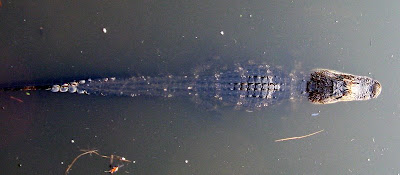 On our whole 100 mile journey on the Wilderness Waterway, we saw very few birds. Many of the birds were killed off at the turn of the century by plume hunters. Because of the fashion rage at the time of adorning beautiful bird feathers on articles of clothing, high prices were paid for the feathers on many of the birds that lived in the glades. Rookeries so thick there were nest on nearly ever branch filled the swamps. Plume hunters would hunt the birds during breeding season when fledglings filled the nests. This is a time when the bird's feathers are the most beautiful. They would shoot all the adult birds, pluck them of their wanted feathers and leave their carcasses there to rot. The fledglings in the nests would be left at the mercy of the hawks and vultures that patrolled the area. Thankfully, this practice was put to an end, but not before much damage was done.
On our whole 100 mile journey on the Wilderness Waterway, we saw very few birds. Many of the birds were killed off at the turn of the century by plume hunters. Because of the fashion rage at the time of adorning beautiful bird feathers on articles of clothing, high prices were paid for the feathers on many of the birds that lived in the glades. Rookeries so thick there were nest on nearly ever branch filled the swamps. Plume hunters would hunt the birds during breeding season when fledglings filled the nests. This is a time when the bird's feathers are the most beautiful. They would shoot all the adult birds, pluck them of their wanted feathers and leave their carcasses there to rot. The fledglings in the nests would be left at the mercy of the hawks and vultures that patrolled the area. Thankfully, this practice was put to an end, but not before much damage was done.



That doesn't mean you won't see anything when you visit the area. We did find pockets of wildlife in different areas. A couple of the best are the Royal Palm area and the Loop Road of the Tamiami Trail. Probably the bieggest concentration of alligators I had ever seen were on the Anhinga Trail. They were in every nook and cranny along the trail.
Since it is breeding season, I was lucky enough one morning to watch and hear the males bellowing to the females. Watching them arch their back and stick their heads out of the water and roar was an experience I'll never forget. The water would vibrate above their bodies. Often, I would find 2 gators next to each other bellowing to some female I couldn't see.
 The Anhinga, or "snake bird" as called by some, can ben seen nearly everywhere there is fresh water. You will either see it swimming with it's head and neck sticking out of the water catching fish or drying it's wings on a sunfilled branch.
The Anhinga, or "snake bird" as called by some, can ben seen nearly everywhere there is fresh water. You will either see it swimming with it's head and neck sticking out of the water catching fish or drying it's wings on a sunfilled branch.

The Great Blue Heron is a large predatory bird that will eat just about anything. I found myself amused with their antics.
A few other common birds found in these southern wetlands are the night herons and the green herons.
I spied a flock of blue winged teal that were late in migrating north for some reason.
We caught several sightings of the Swallow-tailed Kite. It is a beauty to watch as it sails through the skies on it's search for insects.
 Perhaps the bird we saw the most often, was the osprey. In some places, such as Flamingo, there were dozens flying around in view of each other. Nests were sometimes only hundreds of feet away from each other. This bird has definitely made a comeback!
Perhaps the bird we saw the most often, was the osprey. In some places, such as Flamingo, there were dozens flying around in view of each other. Nests were sometimes only hundreds of feet away from each other. This bird has definitely made a comeback!










No comments:
Post a Comment